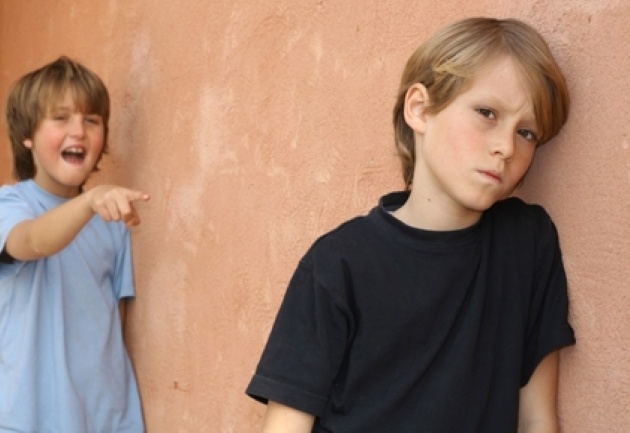“Bullying is not about some bad kids, it’s about relationship problems. Research shows that having one person who will stand u for you is an important protective factor.”
I recently received a call from a mother I will call "Martha", who’s son had been the victim of bullying. This call was a little different, since Martha’s son Tony (not his real name) had been diagnosed with autism. Martha said that she was a “worrier” - but how could she not be; even when all was well, Tony’s limited expressive skills made it difficult to make himself understood, especially when he became upset.
Like most parents, she knew something was going on with Tony at school – all the signs were there. For the first time ever she had trouble getting him ready for the bus in the morning. Unlike the beautiful smile she had grown used to when her son got off the bus in the afternoon, today his light blue eyes were filled with tears. Tony shared with his Mom that two boys were calling him “freak” and “homo” on the bus. They told him that he would be a “baby” if he told his mommy. Tony told his Mom he knew he was not a baby – but he wanted to know why they were calling him a "freak". It was all Martha could do to contain herself until Tony went to bed before she could let go of the sorrow that filled her heart. Her worst night-mare had become a reality. Her vulnerable little angel was being bullied.
Unfortunately students like Tony are not alone; the research shows that students with Special Needs are at greater risk of being targets of bullying. Like their typically developing peers, children with Special Needs want to be accepted and to have friends. This very need to belong can make students like Tony more vulnerable targets. The boys who targeted Tony were aware that they were doing something they should not be doing - or else they would not have said he would be a “baby” if he told his parent. However, it is not necessarily an indication that they dislike Tony. They were bored and had found some easy entertainment with Tony, whose reactions they found amusing. As hard as it may be to believe, many students do not see themselves as “bullies” – in their minds they are joking around and having fun. Regardless of the intent, this behavior is inappropriate and needs to be addressed. With evidence-based interventions implemented by administrators and supportive parents, these boys were given formative consequences, which included research on bullying and community work. The boys on the bus soon became Tony’s allies and even his protectors; this story had a good end.
Unfortunately it’s not always so easy to get to the happy ending. I first met Adam when his family moved to Laval. Back in Ontario, Adam lived in a small community and attended a small school with the same group from kindergarten. His parents worried about moving their son so far from all he knew and from those who loved him. Would his son’s new classmates “adopt” him like a little brother, as the kids in his hometown had? Would they protect him and include him despite his challenges? At first all seemed to go well. Adam returned home with new names and big smiles – he said he had made new friends. If only it was that easy…. Later that week Adam came home without his new DS. Adam happily told his parents that “Steve” was going to be his friend – all he had to do was give Steve his DS.
What was happening to Adam is known as a "conditional friendship", and is often a challenge for students with Special Needs. "Conditional friendships" occurs when a child is permitted to join a group of friends only if s/he gives a possession or carries out some humiliating or forbidden act decided by the group. This type of bullying is particular to children with Special Needs as they are often more naïve, trusting, and eager to be included in a group. Like Adam, often they are not aware that they are targets of bullying. Another example is 10-year-old "Sara", who has a developmental delay. The other girls in her class, who she desperately wants to be friends with, were asking her to dance like "Beyonce". When Sara complied, they laughed and clapped. Sara’s mother sadly says that her daughter "just wanted to please the other kids and fit in, so she did not see [the humiliating act] as a problem". When her Mom tried to explain to Sara that the kids were laughing at her but not with her she just did not understand. Instead she defended the girls, saying they were her "friends".
Tony, Adam, Sara and many other children with and without Special Needs who do not have a good friend, are at increased risk for social isolation and for being targeted for bullying. The research shows that having one person who will stand up for you is an important protective factor.
There are no easy answers to bullying, and no quick fixes. As Dr. Pepler and Dr. Craig tell us, bullying is not about some bad kids, it’s about relationship problems. We don’t have to look far to understand why kids laugh at the weakness or failures in others – we adults have paved the way. Laughing at another’s most humiliating moments has become a national pastime; we call it "Reality TV". If we are to make significant steps towards making schools safe for all students to learn we need to do the opposite – we need to create communities of caring, kindness, and compassion.
Parents of children with challenges and disabilities have a far harder job, but there are tools and strategies which can help keep kids safe. Participating in a social skills group at school or in the community can be very helpful, in that social skill training can help students improve their social understanding and learn how to respond in different social contexts. These structured training sessions take place in small groups and address a range of skills at an age-appropriate level. Skill sets covered typically include winning and losing, asserting one’s self politely, engaging in ‘small talk’, initiating conversation about shared interests, asking others to play, joining in a game, and 'reading' social situations.
Children who have a diagnosis of Asperger / High Functioning Autism find it difficult to ‘read’ social situations. These challenges lead to great difficulty in correctly identifying the thoughts and intentions of other people. As a result, children with this diagnosis may have even more difficulty understanding and distinguishing the behavior of others that may be a mistake or accident, as well as difficulty being able to recognize when someone is repeatedly targeting them. It is important to help young people distinguish between a peer conflict – "he took my eraser without asking", and bullying "he takes your things all the time, even when you ask him not to, and then laughs when you get upset".
Parents can play a pivotal role in teaching their children how to recognize and respond to teasing and bullying through the use of role plays, problem solving social scenarios, social stories and/or cartoon strips. These well-established methods of explaining social situations to children provide step-by-step visual depictions. Of course, a parent’s job is never done - it is very important to monitor and respond to any signs of teasing or bullying from other students. If what your child is experiencing is indeed bullying, role-play and "what if..?" scenarios can be very effective tools in helping children develop and practice new responses. Sometimes younger children benefit from the use of puppets, books or games which focus on problem solving and bullying.
We urge you to please never forget that you are your child’s most important advocate; he or she is counting on you to inform the school immediately when there is a question of mistreatment, to record the details of what happened and to persist until whatever action(s) are taken put an end to the bullying.

 In The Latest Issue:Latest Issue:
In The Latest Issue:Latest Issue:
- A Bittersweet Farewell
- The new Laval Aquatic Co...
- The End of an Era:
Articles
Calendar
Virtual- ANNUAL TEACHER APPRECIATION CONTEST
- APPUI LAVAL
- ARTS & CULTURE
- CAMPS
- CAR GUIDE
- CCIL
- CENTENNIAL ACADEMY
- CHARITY FUNDRAISING
- CITYTV
- COSMODÔME
- COMMUNITY CONNECTIONS
- COVER STORY
- DINA DIMITRATOS
- ÉCOLE SUPÉRIEURE DE BALLET DU QUÉBEC
- EDITORIALS
- ÉDUCALOI
- EDUCATION
- EMPLOYMENT & ENTREPRENEURSHIP
- FÊTE DE LA FAMILLE
- FÊTE DU QUARTIER SAINT-BRUNO
- FAMILIES
- FESTIVAL LAVAL LAUGHS
- FÊTE DE QUARTIER VAL-DES-BRISES
- FINANCES
- GLI CUMBARE
- GROUPE RENO-EXPERT
- HEALTH & WELL-BEING
- 30 MINUTE HIT
- ANXIETY
- CHILDREN`S HEALTH & WELLNESS
- CLOSE AID
- DENTAL WELLNESS
- EXTREME EVOLUTION SPORTS CENTRE
- FONDATION CITÉ DE LA SANTÉ
- GENERAL
- HEARING HEALTH
- MESSAGES FROM THE HEALTH AGENCY OF CANADA
- MENTAL HEALTH
- SEXUALITY
- SOCIAL INTEGRATION
- SPECIAL NEEDS
- TEENS
- THE NUTRITION CORNER
- THE NUTRITION CORNER - RECIPES
- VACATION DESTINATION
- WOMEN'S FITNESS
- WOMEN'S HEALTH
- HILTON MONTREAL/LAVAL
- HOME & GARDEN
- INTERNATIONAL WOMEN'S DAY
- JAGUAR LAVAL
- LAVAL À VÉLO
- LAVAL FAMILIES TV SHOW
- LAVAL FAMILIES MAGAZINE CARES
- LAVAL URBAN IN NATURE
- LE PARCOURS DES HÉROS
- LES PETITS GOURMETS DANS MA COUR
- LEON'S FURNITURE
- LEONARDO DA VINCI CENTRE
- LFM PREMIERES
- LIFE BALANCE
- M.P. PROFILE
- MISS EDGAR'S AND MISS CRAMP'S SCHOOL
- MISSING CHILDREN'S NETWORK
- NETFOLIE
- NORTH STAR ACADEMY LAVAL
- OUTFRONT MEDIA
- PASSION SOCCER
- PARC DE LA RIVIÈRE-DES-MILLE-ÎLES
- PÂTISSERIE ST-MARTIN
- PIZZERIA LÌOLÀ
- PLACE BELL
- PORTRAITS OF YOUR MNA'S
- ROCKET DE LAVAL
- SACRED HEART SCHOOL
- SCOTIA BANK
- SHERATON LAVAL HOTEL
- SOCIÉTÉ ALZHEIMER LAVAL
- STATION 55
- STL
- SUBARU DE LAVAL
- TECHNOLOGY
- TEDXLAVAL
- TODAY`S LAURENTIANS AND LANAUDIÈRE
- TODAY`S LAVAL
- WARNER MUSIC
- THIS ISSUE
- MOST RECENT
Magazine
About Bullying and Students with Special Needs
Articles ~e 105,7 Rythme FM 4 chemins Annual Teacher Appreciation Contest Appui Laval Arts & Culture Ballet Eddy Toussaint Camps THIS ISSUE MORE...
CONTESTS Enter our contests
CONTESTS Enter our contests
CALENDAR
Events & Activities
COMMUNITY Posts Events
PUBLICATIONS Our Magazine Family Resource Directory
LFM BUSINESS NETWORK Learn more
COUPONS Click to save!
COMMUNITY Posts Events
PUBLICATIONS Our Magazine Family Resource Directory
LFM BUSINESS NETWORK Learn more
COUPONS Click to save!
SUBSCRIPTIONS
Subscribe to the magazine
Un-Subscribe
E-NEWSLETTER Subscribe to our E-newsletter Un-Subscribe
WRITE FOR US Guidelines & Submissions
POLLS Vote today!
E-NEWSLETTER Subscribe to our E-newsletter Un-Subscribe
WRITE FOR US Guidelines & Submissions
POLLS Vote today!
ADVERTISERS
How to & Media guide
Pay your LFM invoice
SUGGESTIONS Reader's Survey Suggest a Listing
LFM About Us Our Mission Giving Back Contact Us
SUGGESTIONS Reader's Survey Suggest a Listing
LFM About Us Our Mission Giving Back Contact Us
 PICK-UP LOCATIONS
Get a copy of LFM!
PICK-UP LOCATIONS
Get a copy of LFM!
TERMS & CONDITIONS Privacy | Terms
ISSN (ONLINE) 2291-1677
ISSN (PRINT) 2291-1677
Website by ZENxDESIGN




 BY:
BY: 
Tweet
Share